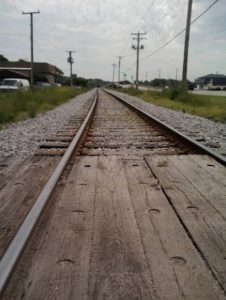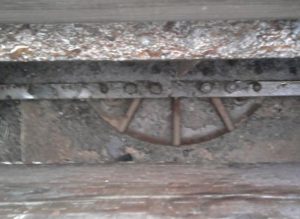Upcoming July 4 fireworks recalls Fox Lake tragedy
By Gregory Harutunian For Chronicle Media — June 14, 2018
Looking south, along Route 12, where spectators watching a fireworks display were hit by a train in 1956. (Photo by Gregory Harutunian/for Chronicle Media)
When it comes to the Village of Fox Lake and fireworks displays, there is a long and distinct history befitting a “resort community.”
For generations, the bays of Fox and Nippersink lakes have been the venues of choice. The Mineola Bay Fourth of July programs were once the most popular in the area, drawing large crowds from both Illinois and Wisconsin, and filling the Chain O’ Lakes waterways with boaters in gathered crafts.
The Fourth of July festivities also marks a tragedy, mostly forgotten except for oral histories and the few rare newspaper accounts that recall a pure Fox Lake tragedy. It involved the 1956 Independence Day fireworks celebration staged on the grounds of the American Legion Post 703, near Route 12 and Riverside Drive.
“I wasn’t born until 1955, and it was before my time, but I remember the stories, hearing about it … such a shame, and sad tragedy,” said Ron Hoehne, Fox Lake Fire Protection District chief. “My father (the former chief Stu Hoehne) joined the force in 1957, and he related it to me. It was similar to the other account.”
That other account came from the late Dr. Mel Platenka, a beloved Fox Lake figure, and the de facto “Mayor of Eagle Point.” His affiliation with the town as a dentist, and member of the Fox Lake-Grant Township Historical Society fueled his passion for area events. During an interview, years ago, he related the events.
“It really happened, and it’s sad. … People had climbed onto the wooden Route 12 bridge, onto the train tracks, to get a better view of the fireworks, at the Legion Hall,” he said. “Everyone was looking at the lake and with all the noise, no one heard or saw the train coming. It plowed right into them. People got killed, limbs were severed, a real tragedy.”
Lighting his pipe, he continued, “They were told to get off the tracks, and I guess they did once, or twice, but it didn’t matter, they were hit.”
Tom Smith, a retired Sheridan, Wyo. freight engineer with the Burlington Northern-Sante Fe Railroad, is aware of such incidents and safety requirements.

The turret built into the wooden Route 12 bridge that was erected for passenger and freight train traffic between Janesville (Wis.) and Chicago. (Photo by Gregory Harutunian/for Chronicle Media)
“It’s all based on speed, how fast the locomotive is going. You have to blow the horn at the 200-foot mark before every grade crossing. It alerts people and traffic, with certain decibel thresholds.
“Freight regulations in that regard aren’t much different from passenger trains, they’re uniform now,” he said. “Our rail lines went through the reservation lands, and at night … it’s critical to let people know a train’s approaching, just to try and avoid accidents.”
The Route 12 span was built for passenger and freight train traffic between Chicago and Janesville, Wis. over Fox and Nippersink lakes. Boat traffic passes underneath by way of a southern channel opening known as “beer can bridge,” and a northern channel access called “the high side,” for taller ships, with a track section that spun on a turret.
The bridge was a perfect viewing site for the fireworks that evening, but one that ultimately proved fatal. A newspaper article, from the now-bygone Antioch News, dated July 5, 1956 described the incident and aftermath.
The article read, in part, “The holiday scene at Fox Lake’s Fourth of July celebration last night was turned into one of tragedy, when a Milwaukee Road vacation special train struck a number of spectators, killing three, and injuring at least five!
“The fireworks display was being staged on the American Legion property … and a number of spectators had climbed the railroad embankment as a vantage point. They were warned by Legionnaires and firemen that the tracks were not safe and a freight train, which came through at 9 p.m., scattered them.
“Many returned to the tracks after passage of the train however. It was at 9:15 p.m., that the tragedy occurred and it is thought that an aerial display of bombs, exploding at the exact time the train rounded a curve was a major factor in failure to see the speeding train … traveling at 55-60 [mph], and that only about six seconds would elapse between coming into sight and the accident point.

The “high side” opening of the Route 12 bridge between Fox and Pistakee lakes for taller boats, where track section spun on a turret. (Photo by Gregory Harutunian/for Chronicle Media)
“Of the three people that were killed: Carl Strand, owner of Wauconda’s Strand Route 12 Motel, and Mrs. Lillian Pavelchik, of Round Lake, along with her 7-year old son, Gary. Among the many injured were Mr. and Mrs. Fred Dittmer, from Grass Lake, saved by their son, Gerald, whom saw the train and pushed them off the tracks.”
The article’s coda mentioned that “a bigger-than-average crowd attended the fire department dance [Saturday] night … with over 3,317 tickets sold.”
Platenka also noted, “There’s so much history out there. I’ve been doing this for more than 25 years, and I’m always learning something new. I’m also always surprised by how relatively recent history can be forgotten.”
—Upcoming July 4 fireworks recalls Fox Lake tragedy–







